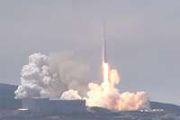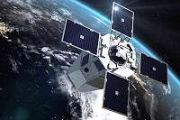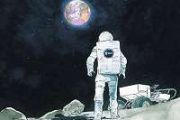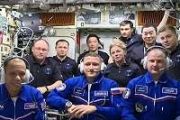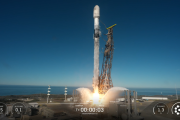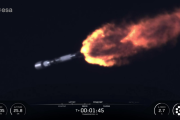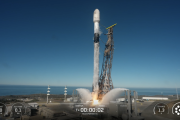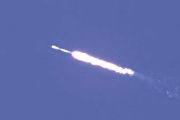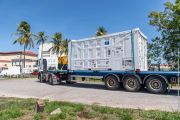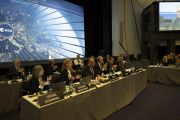
Copernical Team
The beginning of Ignis Mission
 Video:
00:03:10
Video:
00:03:10
These are the highlights of the launch on Axiom Mission 4 (Ax-4) of ESA project astronaut Sławosz Uznański-Wiśniewski from Poland to the International Space Station. The mission is called Ignis.
A SpaceX Falcon 9 rocket lifted off from launch pad 39A at NASA’s Kennedy Space Center in Florida, USA, on 25 June 2025.
Sławosz is mission specialist on the Dragon spacecraft. The other crew members are Shubhanshu Shukla from India and Tibor Kapu from Hungary. They fly under the command of Peggy Whitson from USA.
Sponsored by the Polish government and supported by ESA, the Polish Ministry of Economic Development
Liftoff of Axiom Mission 4
 Video:
00:03:50
Video:
00:03:50
The Axiom Mission 4 (Ax-4) crew lifts off to the International Space Station atop a SpaceX Falcon 9 rocket from launchpad 39A at NASA’s Kennedy Space Center in Florida, USA, on 25 June at 02:31 EDT, local time (07:31 BST/08:31 CEST).
ESA project astronaut Sławosz Uznański-Wiśniewski travels to his new home in space in the Dragon spacecraft. Sławosz is part of Axiom Mission 4 alongside Peggy Whitson (USA), Shubhanshu Shukla (India) and Tibor Kapu (Hungary).
During their journey on the Dragon spacecraft to the orbital outpost Sławosz and Tibor will serve as mission specialists, Shubhanshu will be the crew’s pilot and Peggy will
An instrument to be launched into space will reveal ionic details of the heliosphere
This request seems a bit unusual, so we need to confirm that you're human. Please press and hold the button until it turns completely green. Thank you for your cooperation!
Press and hold the button
If you believe this is an error, please contact our support team.
185.132.36.159 : cd6cdcc3-a683-4e88-af4f-b968b470
India, Poland, Hungary make spaceflight comeback with ISS mission
This request seems a bit unusual, so we need to confirm that you're human. Please press and hold the button until it turns completely green. Thank you for your cooperation!
Press and hold the button
If you believe this is an error, please contact our support team.
185.132.36.159 : 254a4b36-846f-47f7-aa36-2a188296
Living Planet Symposium Extra News: Day 2

ESA’s week-long Living Planet Symposium is in full swing in Vienna, Austria, drawing scientists and researchers from around the world. This flagship event focuses on the latest breakthroughs in Earth science and highlights the advanced space technologies used to observe and understand our changing planet. Throughout the week, we’ll be covering the bigger stories in depth, but we’re also sharing some daily snapshots of other significant happenings.
The major highlight of today was the signing of a landmark agreement between ESA and the Ramsar Convention on Wetlands.
SpaceX Starship prototype explodes during ground test in Texas
This request seems a bit unusual, so we need to confirm that you're human. Please press and hold the button until it turns completely green. Thank you for your cooperation!
Press and hold the button
If you believe this is an error, please contact our support team.
185.132.36.159 : a47004e4-2e66-4cc2-83d5-5618bad9
Construction on Mars takes a leap forward
This request seems a bit unusual, so we need to confirm that you're human. Please press and hold the button until it turns completely green. Thank you for your cooperation!
Press and hold the button
If you believe this is an error, please contact our support team.
185.132.36.159 : 96ca37fd-1f64-40ba-afa4-35fb9eea
North Atlantic’s volcanic secrets – it’s about being thin

Iceland is one of the most active volcanic regions in the world, but its seismic nature is part of a much broader geological history.
In a groundbreaking discovery, scientists, supported by an ESA-funded project, have uncovered the underlying forces that forged the North Atlantic’s fiery volcanic past – shedding light on the vast geological region that spans from Greenland to western Europe, which is home to iconic natural wonders like the Giant’s Causeway in Northern Ireland.
Japanese company blames laser tool for its 2nd crash landing on the moon
This request seems a bit unusual, so we need to confirm that you're human. Please press and hold the button until it turns completely green. Thank you for your cooperation!
Press and hold the button
If you believe this is an error, please contact our support team.
185.132.36.159 : e7495e8e-abea-4f36-a360-d85f7276
Living Planet Symposium Extra News: Day 1

ESA’s week-long Living Planet Symposium kicked off today in Vienna, Austria, bringing together scientists and researchers from around the globe. Throughout the week, we’ll be covering the bigger stories in depth, such as the first images from ESA’s Biomass mission published earlier today – but we’re also sharing some daily snapshots of other significant happenings.
So, today’s few ‘extras’ include Sentinel-2 marking 10 years in orbit, ESA selects Telespazio to run the ground segment for the TRUTHS mission and listen to EarthCARE data transformed into a dragon’s song for peace.

